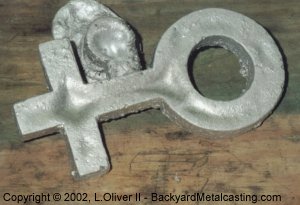
This is a casting suffering from a severe case of shrink cavities. As the metal cools its molecules contract and the casting begins the shrink. Water on the other hand actually expands when solidifying (freezing). As it contracts, excess metal is sucked in toward the center of the casting. If there is no excess metal "feeding" the solidifying casting then there will be a "void" better known as a shrink cavity. The sprue is supposed to supply that extra metal but if the sprue is too small it will cool before the casting and suck metal out of the casting and there's your shrink cavity.
- Use a large sprue.
The sprue should be thicker than the section of the mold it is connected to. I often use 1-1/4-inch diameter closet rod. - Make sure the gates are cut as wide as possible.
Large gates allow the metal in the sprue to stay warm from the heat of the main body of the casting. So the sprue will hopefully cool slower.


Have you ever taken your time preparing a perfect sand mold... you tamp the perfectly tempered sand just right, remove the pattern cleanly, vent the sand nicely, the cavity is clean and sharp and you carry the mold out to your furnace setting it down gently. You pour the shiny, clean aluminum visualizing the new casting you'll have only to be sickened by the sight of the aluminum spilling and oozing out the gap between the cope and drag leaving the flask burnt and charred?
Have you ever experienced that nonsense?? I have... far, far, far ,far (did I mention, far?) too many times. Heck, if you ask me, experiencing it twice is too many times! Thankfully, after reading Metalcasting I learned what the problem was.
Its what I call "gap run-out" and is caused by "hydrostatic pressure" and it deals with the area of physics called "hydrodynamics." Oh yeah.. The Lab's getting technical here! According to the dictionary;
Hydrostatic adj. Of or relating to liquids at rest or to the pressures they exert or transmit.
So what happens is that the molten aluminum pushes against the cope, lifting it up just enough to slide out between the gap. Fortunately you don't need a master's degree in physics to solve the problem. Simply weigh the cope down as shown in the second photo above.
NO PICTURE AVAILABLE
Porous castings are those that have many small holes or bubbles throughout them resulting from gasses (usually hydrogen) trapped in the molten metal. This is often referred to as a "gassy" melt. Fortunately for me I've never experienced this so I haven't been able to experiment with homemade solutions to "gassy metal." However if you're gassy I suggest pepto bismol®. :-)